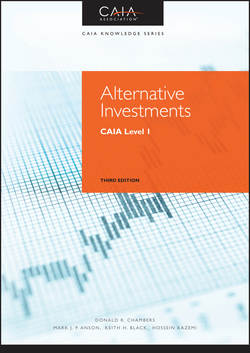Читать книгу Alternative Investments - Hossein Kazemi - Страница 66
PART One
Introduction to Alternative Investments
CHAPTER 4
Statistical Foundations
4.3 Covariance, Correlation, Beta, and Autocorrelation
4.3.4 The Correlation Coefficient and Diversification
ОглавлениеThe correlation coefficient is often used to demonstrate one of the most fundamental concepts of portfolio theory: the reduction in risk found by combining assets that are not perfectly positively correlated. Exhibit 4.3 illustrates the results of combining varying portions of assets A and B under three correlation conditions: perfect positive correlation, zero correlation, and perfect negative correlation.
Exhibit 4.3 Diversification between Two Assets
The highest possible correlation and least diversification potential is when the assets' correlation coefficient is positive: perfect positive correlation. The straight line to the lower right between points A and B in Exhibit 4.3 plots the possible standard deviations and mean returns achievable by combining asset A and asset B under perfect positive correlation. The line is straight, meaning that the portfolio risk is a weighted average of the individual risks. This illustrates that there are no benefits to diversification when perfectly correlated assets are combined. The idea is that diversification occurs when the risks of unusual returns of assets tend to cancel each other out. This does not happen in the case of perfect positive correlation, because the assets always move in the same direction and by the same proportion.
The greatest risk reduction occurs when the assets' correlation coefficient is −1: perfect negative correlation. The two upper-left line segments connecting points A and B in Exhibit 4.3 plot the possible standard deviations and mean returns that would be achieved by combining asset A and asset B under perfect negative correlation. Notice that the line between A and B moves directly to the vertical axis, the point at which the standard deviation is zero. This illustrates ultimate diversification, in which two assets always move in opposite directions; therefore, combining them into a portfolio results in rapid risk reduction, or even total risk reduction. This zero-risk portfolio illustrates the concept of a perfect two-asset hedge and occurs when the weight of the investment in asset A is equal to the standard deviation of asset B divided by the sums of the standard deviations of A and B.
But the most realistic possibility is represented by the curve in the center of Exhibit 4.3. This is the more common scenario, in which the assets are neither perfectly positively nor perfectly negatively correlated; rather, they have some degree of dependent movement. The key point to this middle line in Exhibit 4.3 is that when imperfectly correlated assets are combined into a portfolio, a portion of the portfolio's risk is diversified away. The risk that can be removed through diversification is called diversifiable, nonsystematic, unique, or idiosyncratic risk.
In alternative investments, the concept of correlation is central to the discussion of portfolio implications. Further, graphs with standard deviation on the horizontal axis and expected return on the vertical axis are used as a primary method of illustrating diversification benefits. Assets that generate diversification benefits are shown to shift the attainable combinations of risk and return toward the benefit of the investor, meaning less risk for the same amount of return. The key point is that imperfect correlation leads to diversification that bends portfolio risk to the left, representing the improved investment opportunities afforded by diversification.
In the case of asset returns, true future correlations can only be estimated. Past estimated correlation coefficients not only are subject to estimation error but also are typically estimates of a moving target, since true correlations should be expected to change through time, as fundamental economic relationships change. Further, correlation coefficients tend to increase (offer less diversification across investments and asset classes) in times of market stress, just when an investor needs diversification the most.
